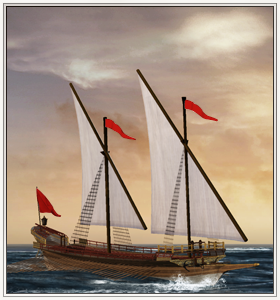Difference between revisions of "Galley (ETW Unit)"
Tango12345 (talk | contribs) (Created page with "{{Unit|image=Galley.png|Class=Medium Galley|Men=74|Guns=2|Recruitable From=Fishing Fleet, Dockyard, Commercial Port|Region=The Baltic and Mediterranean|Recruitment Cost=430|U...") |
Tango12345 (talk | contribs) |
||
| Line 1: | Line 1: | ||
| − | {{Unit|image=[[Galley.png]]|Class=Medium Galley|Men=74|Guns=2|Recruitable From=Fishing Fleet, Dockyard, Commercial Port|Region=The Baltic and Mediterranean|Recruitment Cost=430|Upkeep Cost=100|Technology Needed=None}} | + | {{Unit|image=[[image:Galley.png]]|Class=Medium Galley|Men=74|Guns=2|Recruitable From=Fishing Fleet, Dockyard, Commercial Port|Region=The Baltic and Mediterranean|Recruitment Cost=430|Upkeep Cost=100|Technology Needed=None}} |
==Overview== | ==Overview== | ||
Revision as of 09:01, 22 January 2011
Overview
Although made obsolescent by the rise of broadside-firing sailing ships, galleys still have a place in naval warfare. The wind (or its lack) does not limit their movement and, if well handled, galleys can run rings around sailing ships. A galley has a reasonable amount of firepower for its size with cannons on a firing platform, or with a full gun deck above the rowers (on a design called a galleas). Up to five men work each oar; these are convicts (at best) or slaves (at worst). The life of a rower is hard, brutal and can be short: chained to their oars, they will go down with the galley if it founders.
The galley’s main disadvantage is its vulnerability in heavy seas: it would almost certainly sink in a full Atlantic seaway. It is most useful in relatively calm waters such as the Mediterranean or Baltic. These smaller seas also help keep a galley close to port: the large crew size means that they cannot venture far from a supply port, making them unsuitable for trans-oceanic voyages.
Historically, the galley survived for a long time as a practical warship in sheltered waters. The Ottomans, Swedes and Russians all used them in their battle fleets. As late as the 1790s they were still in use in the Baltic and the Mediterranean (C. S. Forrester has his famous fictional hero Captain Horatio Hornblower face Spanish galleons in one encounter). North African corsairs also used galleys, as they had a ready supply of European slaves to serve in them.
